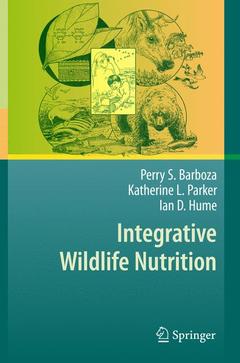Integrative Wildlife Nutrition, 1st ed. 2009. 2nd printing 2009
Langue : Français

Nutrition spans a wide range of mechanisms from acquisition of food to digestion, absorption and retention of energy substrates, water and other nutrients. Nutritional principles have been applied to improving individual health, athletic performance and longevity of humans and of their companion animals, and to maximizing agricultural efficiency by manipulating reproduction or growth of tissues such as muscle, hair or milk in livestock. Comparative nutrition borrows from these tra- tional approaches by applying similar techniques to studies of ecology and physiology of wildlife. Comparative approaches to nutrition integrate several levels of organization because the acquisition and flow of energy and nutrients connect individuals to populations, populations to communities, and communities to ecosystems. Integrative Wildlife Nutrition connects behavioral, morphological and biochemical traits of animals to the life history of species and thus the dynamics of populations. An integrated approach to nutrition provides a practical framework for understanding the interactions between food resources and wildlife popu- tions and for managing the harvest of abundant species and the conservation of threatened populations. This book is for students and professionals in animal physiology and ecology, conservation biology and wildlife management. It is based on our lectures, dem- strations and practical classes taught in the USA, Canada and Australia over the last three decades. Instructors can use Integrative Wildlife Nutrition as a text in wildlife and conservation biology programs, and as a reference source for related courses in wildlife ecology.
Functional Relationships.- Introduction: Common Themes Across Diverse Taxa.- Food and Populations.- Feeding Dynamics: Functional and Behavioral Responses.- Measuring Food Consumption.- Digestive Function.- Substrates and Tissue Constituents.- Carbohydrates: Sugars, Fiber and Fermentation.- Lipids: Fatty Acids and Adipose Tissue.- Nitrogenous Substrates: Nucleic Acids to Amino Excretion.- Metabolic Constituents: Water, Minerals and Vitamins.- Energy and Integration.- Energy: Carbon as a Fuel and a Tissue Constituent.- Integrating Nutrient Supply and Demand in Variable Environments.
Elucidates the importance of wildlife nutrition from molecules and cells to ecosystems Key concepts are illustrated with flow diagrams of biochemical pathways and with practical examples for monitoring the nutritional status of wild animals Includes supplementary material: sn.pub/extras
Date de parution : 11-2009
Ouvrage de 342 p.
15.5x23.5 cm
Date de parution : 01-2009
Ouvrage de 342 p.
15.5x23.5 cm
Thèmes d’Integrative Wildlife Nutrition :
© 2024 LAVOISIER S.A.S.



